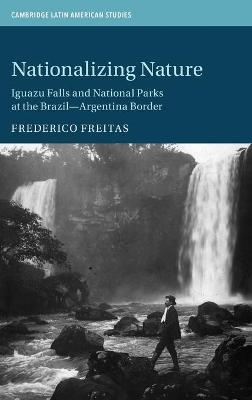
Nationalizing Nature
Iguazu Falls and National Parks at the Brazil-Argentina Border
Seiten
2021
Cambridge University Press (Verlag)
978-1-108-84483-3 (ISBN)
Cambridge University Press (Verlag)
978-1-108-84483-3 (ISBN)
Nationalizing Nature demonstrates how Brazil and Argentina employed national parks to develop and settle frontier areas, casting light on conservation's crucial role in the territorial growth of the region. In the process, a distinct national park model – combining the preservation of nature and settler colonization – is highlighted.
Today, one-quarter of all the land in Latin America is set apart for nature protection. In Nationalizing Nature, Frederico Freitas uncovers the crucial role played by conservation in the region's territorial development by exploring how Brazil and Argentina used national parks to nationalize borderlands. In the 1930s, Brazil and Argentina created some of their first national parks around the massive Iguazu Falls, shared by the two countries. The parks were designed as tools to attract migrants from their densely populated Atlantic seaboards to a sparsely inhabited borderland. In the 1970s, a change in paradigm led the military regimes in Brazil and Argentina to violently evict settlers from their national parks, highlighting the complicated relationship between authoritarianism and conservation in the Southern Cone. By tracking almost one hundred years of national park history in Latin America's largest countries, Nationalizing Nature shows how conservation policy promoted national programs of frontier development and border control.
Today, one-quarter of all the land in Latin America is set apart for nature protection. In Nationalizing Nature, Frederico Freitas uncovers the crucial role played by conservation in the region's territorial development by exploring how Brazil and Argentina used national parks to nationalize borderlands. In the 1930s, Brazil and Argentina created some of their first national parks around the massive Iguazu Falls, shared by the two countries. The parks were designed as tools to attract migrants from their densely populated Atlantic seaboards to a sparsely inhabited borderland. In the 1970s, a change in paradigm led the military regimes in Brazil and Argentina to violently evict settlers from their national parks, highlighting the complicated relationship between authoritarianism and conservation in the Southern Cone. By tracking almost one hundred years of national park history in Latin America's largest countries, Nationalizing Nature shows how conservation policy promoted national programs of frontier development and border control.
Frederico Freitas is an Assistant Professor of Digital and Latin American History and a core member of the Visual Narrative Initiative at North Carolina State University. He is the co-editor of Big Water: The Making of the Borderlands Between Brazil, Argentina, and Paraguay (with Jacob Blanc, 2018) and a recipient of an NEH fellowship.
Introduction: Boundaries of nature; 1. Nationalizing the border; 2. Playing catch-up; 3. A park and a town; 4. Land conflict; 5. Surveillance and evasion; 6. The view from above; The resilience of boundaries.
| Erscheinungsdatum | 24.02.2021 |
|---|---|
| Reihe/Serie | Cambridge Latin American Studies |
| Zusatzinfo | Worked examples or Exercises |
| Verlagsort | Cambridge |
| Sprache | englisch |
| Maße | 150 x 230 mm |
| Gewicht | 630 g |
| Themenwelt | Geisteswissenschaften ► Geschichte ► Regional- / Ländergeschichte |
| Naturwissenschaften ► Biologie ► Ökologie / Naturschutz | |
| ISBN-10 | 1-108-84483-9 / 1108844839 |
| ISBN-13 | 978-1-108-84483-3 / 9781108844833 |
| Zustand | Neuware |
| Haben Sie eine Frage zum Produkt? |
Mehr entdecken
aus dem Bereich
aus dem Bereich


